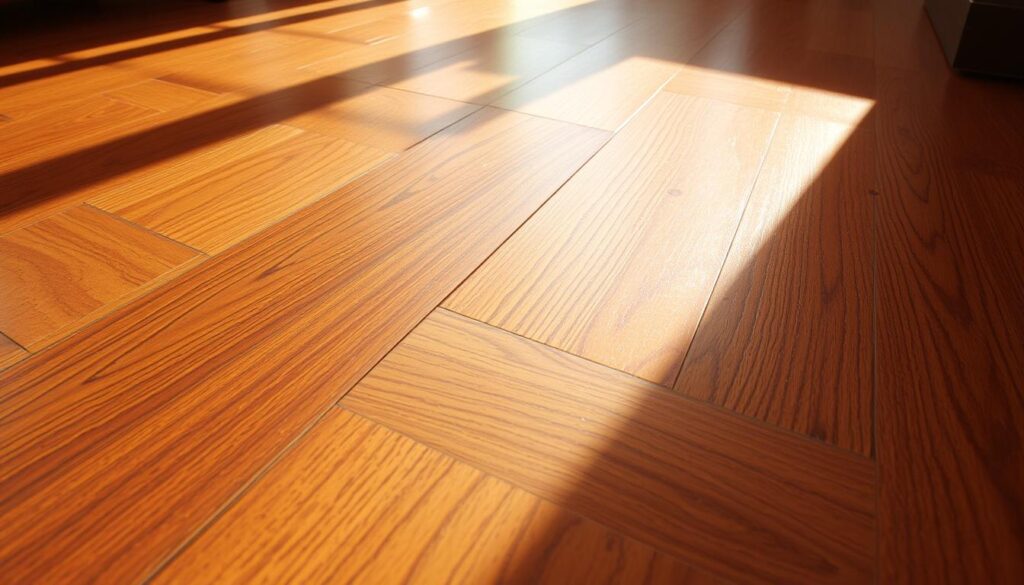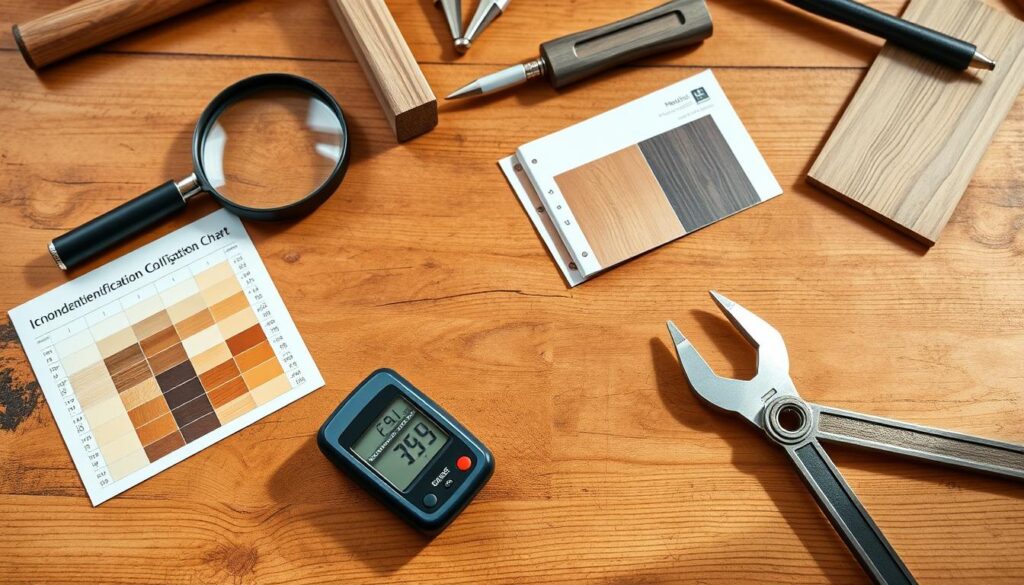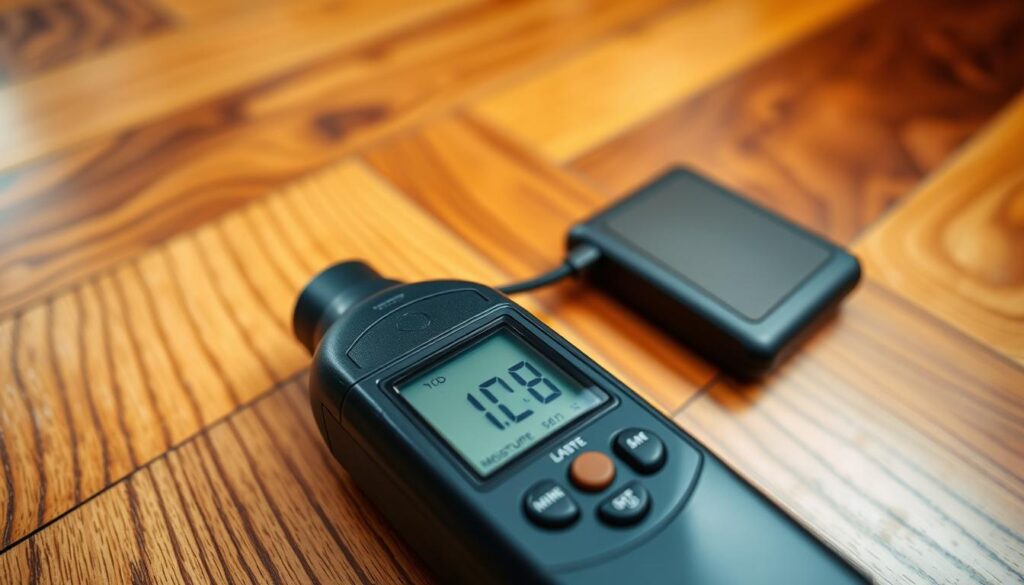Learn how to identify flooring material hardwood with our comprehensive guide. Discover key characteristics, patterns, and expert tips to determine your floor type accurately.
Knowing what type of flooring you have is key to keeping it in great shape. Hardwood floors are popular for their timeless beauty. But, telling real hardwood from fake can be tricky, thanks to many wood-like options out there. This guide will help you spot hardwood floors and make sure you’re choosing the best quality.

Key Takeaways
- Learn the key characteristics of genuine hardwood flooring
- Discover the differences between natural and engineered hardwood floors
- Understand the various wood species used in hardwood flooring
- Explore testing methods to confirm the authenticity of your hardwood floors
- Identify common hardwood alternatives and look-alikes
Understanding the Basics of Hardwood Flooring
Exploring hardwood flooring is a fascinating journey. It shows the wide range of wood species and the differences between natural and engineered hardwood. Knowing these basics helps you identify the flooring in your home or office.
Types of Wood Species Used in Flooring
The choice of wood species affects the look and durability of hardwood floors. Popular options include oak, maple, hickory, and walnut. Each has its own grain patterns, colors, and characteristics. Learning about these can help you choose the right flooring for your space.
Natural vs. Engineered Hardwood Differences
Choosing between natural and engineered hardwood is a common dilemma. Natural hardwood, made from solid wood, has a timeless charm and lasts long. Engineered hardwood, with a real wood top layer and a strong core, is more affordable and stable. Knowing the pros and cons of each helps you decide what’s best for you.
Common Hardwood Grades and Classifications
The hardwood flooring industry uses a grading system. It categorizes hardwood grades by appearance, defects, and quality. From “Select” to “Character” grade, each has its own look and price. This lets you find flooring that fits your style and needs.
| Hardwood Grade | Characteristics | Typical Applications |
|---|---|---|
| Select | Uniform color, minimal knots and imperfections | High-end residential and commercial spaces |
| No. 1 Common | Moderate character, some knots and color variations | Mid-range residential and light commercial applications |
| No. 2 Common | Rustic appearance, more pronounced knots and character | Budget-friendly residential and utilitarian spaces |
Understanding hardwood flooring basics is key. It includes knowing the wood species, the natural and engineered hardwood differences, and the hardwood grades. This knowledge helps you make a smart choice that fits your needs and style.
Visual Characteristics of Genuine Hardwood Floors
Spotting real hardwood floors is an art that needs a sharp eye for detail. As you dive into the world of wood flooring, watch for the unique wood grain patterns, hardwood textures, and floor coloration. These features make genuine hardwood stand out from fake ones.
Real hardwood floors have a captivating mix of natural variations. Each board has its own special wood grain patterns, with lines and swirls that vary. These patterns give the flooring depth and character, making it truly unique.
Also, genuine hardwood floors come in a variety of surface textures. You might find a floor that’s smooth and polished or one that’s weathered and rustic. These textures add interest and feel to the space.
The floor coloration also shows the natural beauty of hardwood. Colors can range from maple’s warm tones to walnut’s deep, rich shades. Each type of wood has its own color palette, adding to the floor’s charm.
By learning to recognize these visual signs, you can tell real hardwood floors from fakes. This ensures your space has the timeless elegance and character of hardwood.
“Hardwood floors are like a work of art, each one a unique masterpiece.”
How to Identify Flooring Material Hardwood
Knowing the type of hardwood in your flooring is key to keeping it looking great and lasting long. By learning about wood texture analysis, grain identification, and hardwood color assessment, you can figure out the exact wood species. This ensures your flooring is truly made of hardwood.
Surface Texture Analysis
Checking the surface texture of your flooring is a crucial step. Run your hand over the floor and notice how it feels. Is it smooth or does it have a clear grain pattern? Hardwoods like oak, maple, and cherry have unique textures that can be felt.
Grain Pattern Recognition
The grain pattern of the wood is also a key indicator. Look at the floor closely to see the grain direction, spacing, and overall look. Oak has a bold, clear grain, while maple has a finer, more even pattern. Knowing the grain patterns of different hardwoods helps you identify them accurately.
Color and Tone Assessment
The color and tone of your hardwood flooring can also give clues about the wood species. Hardwood colors vary from cherry’s warm reddish-brown to maple’s pale blonde. Look at the overall color and any variations or undertones. This, along with texture and grain analysis, helps you identify the hardwood type.
By getting good at these identification skills, you can make sure your hardwood floors are real and take care of them well. For more expert advice on hardwood flooring identification and care, contact us at Timber Tropics. Phone Number +6282332572828 Email: info@timbertropics.com.
Video source from youtube
Tools and Equipment Needed for Wood Identification
Knowing the type of hardwood flooring in your home or a property you’re interested in is useful. To figure out the wood species and if it’s real, experts use special tools. Here are the key items you need for your own wood identification checks.
Moisture Meters
First, you need to check the wood’s moisture level. Moisture meters give exact readings with their sensors. This helps tell real hardwood from fake ones. Knowing the moisture level tells you about the flooring’s condition and if it’s genuine.
Hardness Testers
A hardness tester, like a Janka tester, is also key. It shows how hard the wood is by how much force it takes to embed a steel ball. This tells you about the wood’s density and type. It helps spot the difference between soft and hard woods.
Magnifying Glasses
A good magnifying glass or loupe is great for looking closely at the wood. It lets you see the grain, color, and other details up close. With a trained eye, you can often tell the wood species by these small details.
| Tool | Purpose | Key Features |
|---|---|---|
| Moisture Meter | Measure wood moisture content | Digital display, pin-type or pinless sensors |
| Hardness Tester | Assess wood density and species | Janka hardness scale, portable design |
| Magnifying Glass | Examine wood grain and details | High magnification, adjustable focus |
With these wood identification tools, you can be sure about the hardwood flooring’s authenticity and type. This helps you make smart choices about your home or investment. Remember, getting good at wood identification takes practice and knowledge.

Testing Methods to Confirm Authentic Hardwood
Identifying genuine hardwood flooring isn’t always easy. You can’t just look at it. It’s important to use different tests to make sure it’s real. Let’s look at three main ways to check if your hardwood floors are genuine.
Moisture Content Testing
Checking the wood’s moisture is key. Good hardwood floors have a moisture level of 6-9%. This ensures they are stable and strong. A wood moisture meter can quickly check the moisture levels of your floors.
Hardness Testing Techniques
The Janka hardness test is a well-known way to check wood durability. It measures how hard the wood is by seeing how deep a steel ball can sink. By comparing your floor’s Janka rating to known hardwoods, you can confirm it’s real.
Surface Scratch Tests
Hardwood floors are known for being scratch-resistant. Try scratching your floor with a coin or key. Real hardwood should not scratch easily. This test can help you tell if your floor is genuine or not.
Using these tests, you can be sure your hardwood floors are genuine. They will last long and look great for years.

| Test | Purpose | Ideal Range |
|---|---|---|
| Moisture Content | Measure the moisture level in the wood | 6-9% |
| Janka Hardness | Evaluate the durability and scratch resistance of the wood | Varies by species |
| Surface Scratch | Assess the scratch resistance of the wood surface | Minimal to no visible scratches |
These tests are crucial for confirming your hardwood floors are genuine. They protect your investment in quality wood. By verifying your flooring, you can enjoy its beauty and durability for many years.
“Proper testing is the key to identifying authentic hardwood floors and ensuring a lasting, high-quality investment.”
Common Hardwood Alternatives and Look-alikes
It’s important to know the difference between real hardwood and its look-alikes like laminate flooring, vinyl planks, and wood-look tiles. Knowing what you have can help avoid mistakes and ensure you get what you expect.
Hardwood floors feel natural and uneven, unlike the smooth surfaces of laminate and vinyl. Hardwood also has a unique grain pattern that look-alikes can’t quite match. This difference in texture and grain is key to telling them apart.
The color of the floor can also give it away. Hardwood floors have a warm, rich color that changes with the wood type and finish. Laminate and vinyl, on the other hand, have a more uniform, artificial color.
Wood-look tiles are easy to spot because they don’t have the real wood’s texture and grain. They might look like hardwood, but they’re not the real thing.
To figure out what your floor is made of, look closely and touch it. If you’re still unsure, a flooring expert can help. Knowing the difference between hardwood and its look-alikes helps you make better choices.
For more information or to schedule a consultation, please contact Timber Tropics at +6282332572828 or info@timbertropics.com.
Age and Wear Pattern Analysis
When looking at antique hardwood floors, age and wear patterns are key. These signs help tell if a floor is truly old or just looks that way. By checking these signs, you can spot real vintage floors from fake ones.
Historical Flooring Indicators
Old hardwood floors show their age in many ways. For example:
- Uneven board widths, showing hand-sawing
- Saw marks or tool marks on the wood
- Mortise and tenon joints, common in old buildings
- Unique colors and patina from years of aging
Traffic Pattern Assessment
Looking at wear patterns can also tell a floor’s story. You might see:
- Uneven wear in busy spots like entryways
- Patterns that show where furniture or rugs used to be
- Wood that’s darker or lighter in places, from foot traffic and sunlight
By studying these signs, you learn a lot about an antique floor’s history. This info is crucial for restoring or keeping these floors in top shape.
| Characteristic | Indication |
|---|---|
| Uneven board widths | Hand-sawing techniques |
| Visible saw marks | Pre-20th century construction |
| Mortise and tenon joints | Older craftsmanship |
| Unique color variations | Natural aging and patina |
| Uneven wear patterns | High-traffic areas and usage history |
For more info or to book a professional check, call us at +6282332572828 or info@timbertropics.com.
Professional Inspection Techniques
Professional inspectors use advanced techniques to identify hardwood flooring materials. They rely on their deep knowledge and follow industry standards. This helps them tell real hardwood from fake or similar materials.
They check the surface texture, grain patterns, and color tones. This way, they can spot genuine hardwood from imitations or alternatives.
Moisture content testing is key in their work. They use special moisture meters to check the wood’s humidity levels. This helps them tell if it’s real hardwood or a synthetic.
They also test the hardness of the flooring. This shows the wood’s density and durability. It confirms if the flooring is authentic.
Experts do surface scratch tests to see how the material holds up. This tells them about the floor’s age, history, and how much traffic it’s seen. By using these methods, they can accurately identify your hardwood floors.
If you have questions about identifying wood floors or want an inspection, contact Timber Tropics. Call +6282332572828 or email info@timbertropics.com. Our team is ready to help with all your hardwood flooring needs.
FAQ
What are the different types of wood species used in hardwood flooring?
Oak, maple, cherry, walnut, and hickory are common in hardwood floors. Each has its own look, color, and hardness.
How can I distinguish between natural and engineered hardwood flooring?
Natural hardwood is solid wood all the way through. Engineered hardwood has a real wood top layer over plywood or composite. Engineered is more stable but might not look the same as solid wood.
What are the common hardwood grades and classifications?
Hardwood floors are graded as clear, select, and common. Clear is the best and most even. Common has more natural features like knots and streaks.
How can I identify the visual characteristics of genuine hardwood floors?
Look for unique grain patterns, natural colors, and textures. Real hardwood has a more detailed and irregular grain than fake flooring.
What tools and equipment are needed for wood identification?
You’ll need moisture meters, hardness testers, magnifying glasses, and scratch tools. These help check the wood’s moisture, hardness, and texture.
How can I test for authentic hardwood using various methods?
Use moisture content tests, hardness checks, and scratch tests. These methods prove if the flooring is real hardwood or not.
What are some common hardwood alternatives and look-alikes?
Laminate, vinyl planks, and wood-look tiles are popular but not real hardwood. They look like hardwood but don’t have the same feel or look.
How can I analyze the age and wear patterns of hardwood floors?
Look for signs like tongue-and-groove construction or hand-scraped surfaces. Also, check the wear patterns to guess the floor’s age and condition.
What techniques do professionals use to inspect and identify hardwood flooring?
Experts use core sampling, microscopic analysis, and special testing tools. These methods give a detailed and accurate hardwood floor identification.
Related article : Best Waterproof Wood Flooring Options for Your Home
